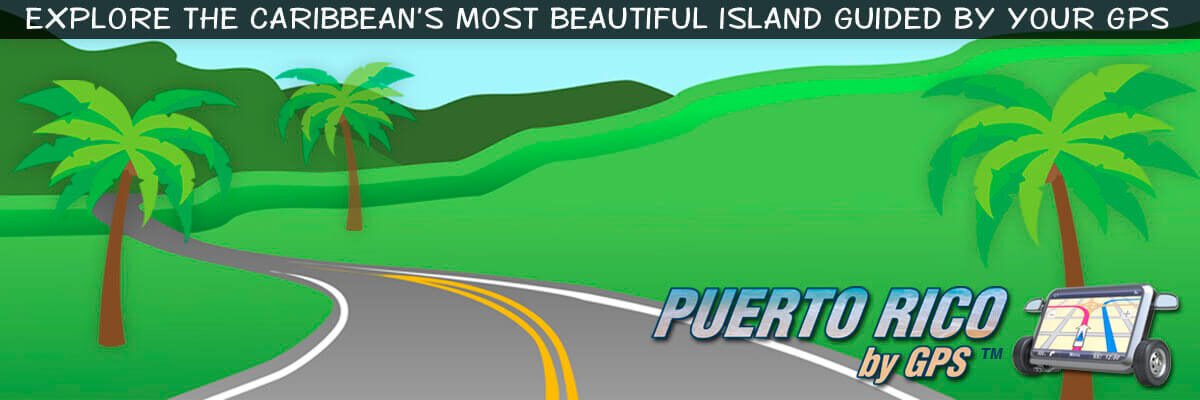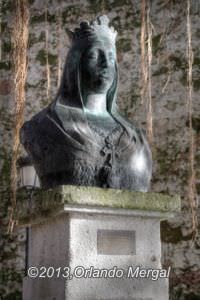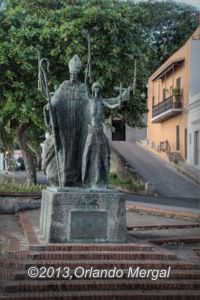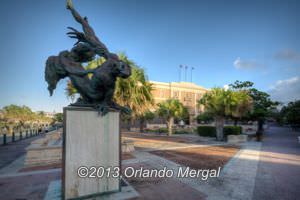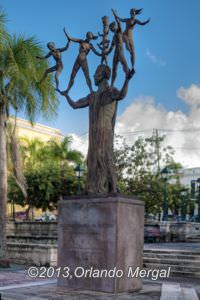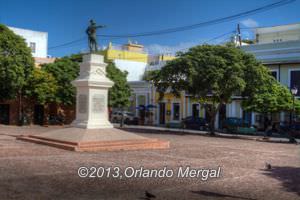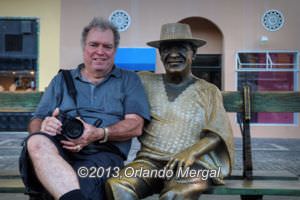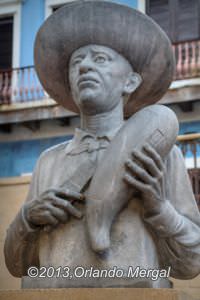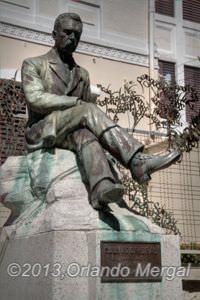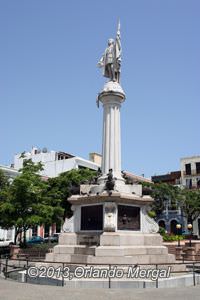After you pass “La Princesa Promenade” and the “Raíces” fountain there’s a walkway that borders the San Juan city wall all the way to the base of Fort San Felipe del Morro. However, today we’ll only be following this walkway to San Juan Gate, where visitors to Puerto Rico would disembark during early colonial times.
A few steps before reaching San Juan Gate there’s another bust that most visitors miss. It is dedicated to “Isabel de Trastamara”, better known in historical terms as Queen Isabella I of Spain, and also known as Isabella the Catholic.
Queen Isabella I married Ferdinand II of Aragon and together they liberated Spain from Moorish rule in 1492, the same year that Christopher Columbus went on his first voyage of discovery. What’s more, it was Isabella who convinced Ferdinand to finance Columbus’ voyage, thus opening the doors to a new world and the riches that came with it.
The bust of Queen Isabella II is in a small square that sits about 100 feet before San Juan Gate, right next to the city wall. It’s covered by dense vegetation that doubles as an excellent place to rest for a while before continuing on your own little voyage of discovery.
Right after entering San Juan Gate you will notice a narrow tree-covered walkway leading uphill to your left that extends diagonally along Clara Lair street. It leads to “La Plaza de la Rogativa” which would loosely translate as “Procession Square”.
The sculpture in the center of the square was commissioned in 1971 by a group of Puerto Rican businessmen to commemorate Ralph Abercromby’s failed siege of the city of San Juan. After failing to take San Juan in 1797, the British Lieutenant-General ordered a naval blockade to cut off Spanish reinforcements.
After witnessing the anguish of his troops and citizens for weeks, the Spanish governor called for a procession or “rogativa” to implore for divine intervention. The women of San Juan organized a procession and marched through the streets carrying torches and rustic instruments. Apparently, Abercromby mistook the procession for the arrival of Spanish reinforcements and fled the Island fearing that he would be outnumbered and defeated.
“La Plaza de la Rogativa” offers an excellent view of the north side of Santa Catalina Palace as well as the portion of the city wall leading to Fort San Felipe Del Morro.
After passing “La Plaza de la Rogativa” you will see an iron gate to the west. Follow that road until you reach a fork where there’s a colonial structure painted in bright pink. It’s called “la casa rosada” and it’s covered elsewhere on this site in great detail. Take the road on the right (the one that goes uphill) and follow it until you reach a small round square at the entrance to the El Morro Grounds.
We already covered Fort San Felipe del Morro in a previous post, so we’ll be turning right at his corner.
If you look on your left you will see a huge three-story building painted in beige and light brown with a beautiful statue right at the corner. That’s the Ballajá Military Barracks building and it’s covered in great detail elsewhere on this site. The statue —however— was unveiled in 1992 during the Quincentennial Celebration of the Discovery of America and it commemorates the rescue of the Ballajá Ward by the Puerto Rican people.
Continuing up the street, to the right of the Ballajá Military Barracks, there’s another small square dedicated to Eugenio María de Hostos. This is the square that I mentioned in Part 1 of this post. And I wish I could say that this square is clean and well kept, but it’s not. The place is filthy, smelly, covered in graffiti and ridden with teenagers on skateboards and homeless people. And then, the placard below the statue cynically says that it’s dedicated to the “Citizen of the Americas” on behalf of a grateful homeland. Yeah right, very grateful!
Turning left at la “Plaza de los Niños” you’ll see San José Church at the very end of the street. This church has been closed for restoration for many years. However, right next to the church is a beautiful square with a statue of Juan Ponce de León in the center.
The metal for this statue reportedly came from the melted canons and guns that were recovered from the English ships destroyed during a failed attack on el Morro during the 16th Century.
The Statue was originally placed at “Plaza de Santiago”, which was right behind the now demolished Santiago Gate on the east side of the city. On January 23rd, 1894 it was replaced by the now famous Christopher Columbus statue and the square was renamed as Plaza Colón. Since then, the statue of Juan Ponce de León has adorned the beautiful Plaza San José.
There are lots of benches for people watching and many cafes and restaurants all around where you can experience Puerto Rican cuisine at its best.
From Plaza San José we’ll continue east on Calle San Sebatián to the corner with San José Street. We’ll go down San José Street until we reach “Plaza De Armas”, the beautiful square that’s right in front of City Hall. On the south side of the square there’s a statue that actually doesn’t look like a statue at all. It’s dedicated to Tite Curet Alonso, a world famous Puerto Rican “salsa” composer who wrote over 2,000 songs during his long and illustrious career.
But “Tite” doesn’t stand tall and mighty for all to see. Instead he’s just sitting there, waiting for you to sit by his side and have your picture taken. And you know why? Because that’s who “Tite“ was; humble, friendly, open and inviting. A true gem among all Puerto Ricans.
And I? Well, I couldn’t resist. After all, that’s what “Tite” would’ve wanted.
As far as a placard goes, I didn’t see any. Most people sit next to “Tite”, have their picture taken and never get to know who he was. A sign to the side of the bench with a little information would be nice.
From there we’ll walk east down San Francisco Street until we reach “La Plaza de La Barandilla”. I was there last Sunday and I felt like a little kid with a new toy. They fixed it!!!
What on earth am I talking about? Well, several months ago I was very critical about how this square had been severely vandalized. Some of the bronze railings were missing or bent out of shape and others had simply been cut off to be sold as scrap metal. It was a sad spectacle.
Well, this time I was pleasantly surprised. All of the railings have been fixed and the place was gleaming clean! And when I say gleaming I do mean gleaming. I don’t know what they used exactly, but they applied some sort of chemical to the bronze that made look shiny and beautiful. Yes!!!
At the northwest corner of this square there’s a bust dedicated to Patricio Rijos, King of the Puerto Rican “Güícharo”. “Güicharo” is what the Puerto Ricans call the instrument commonly known as a güiro.
“The güiro (Spanish pronunciation: [Gwiro]) is a Latin-American percussion instrument consisting of an open-ended, hollow gourd with parallel notches cut in one side. It is played by rubbing a stick or tines along the notches to produce a ratchet-like sound.
The güiro is commonly used in Puerto Rican and other Latin-American music, and plays a key role in the typical rhythm section of important genres like cumbia and son. Playing the güiro usually requires both long and short sounds, made by scraping up and down in long or short strokes.” Wikipedia
Well, when it came to playing “güícharo”, “Toribio” was the premier performer among all “güireros” on the Island. Believe me, this guy could play. Sadly, the last time that I went by this bust (June,2013) some clown has painted a bright red kiss on one of his cheeks. But last Sunday I was happy to see that once again it’s back to a pristine state.
Right next to “La Barandilla” there’s a smaller square that’s right in front of the entrance to San Francisco Church. It is dedicated to Salvador Brau, a Puerto Rican journalist, poet, writer and historian.
And finally, continuing down San Francisco Street you’ll arrive at Plaza Colón where there’s a huge statue of Christopher Columbus. Originally this square was called Plaza Santiago because it sat directly behind Santiago Gate, one of the five original gates of the city wall. But in 1897 city officials ordered the demolition of a portion of the wall to allow the city to grow to the west.
At that time the statue that stood in the middle of Santiago Square was the one in honor of Juan Ponce de León. The same one that’s presently at Plaza San José. When the Plaza was rechristened as Plaza Colón the Ponce de León statue was moved to Plaza San José and the new Columbus statue took its place.
Last Sunday I noticed that the square was recently cleaned and painted for the Christmas season. I loved it.
Sometimes I feel like I’m a little too hard on the City when I see places that are dirty or in poor condition. But I don’t criticize just to criticize. I do it because Puerto Rico is my home and Old San Juan is my favorite city. So I enjoy showing it off to the world.
And I know that I have said this before, but what the heck, I’m going to say it again. I believe that every country has certain God-given advantages. And in the case of Puerto Rico it’s the island itself. This place is great!!!
I truly believe that if Puerto Ricans put their minds to it the Island could become one of the greatest tourist destinations in the world. I mean… the place has everything. And of all the great things there are to see and do in Puerto Rico Old San Juan is by far the crown jewel.
So that’s why I do it; because I want Old San Juan (and Puerto Rico as a whole) to get better and better.
Oh, and I almost forgot. Yesterday I saw in the news that there’s a huge cold front in the mainland that’s going to cover the entire east coast in bright white. Now would be a great time to spend a couple of weeks in sunny Puerto Rico. Come on over. The sun is great!!!
Enjoy Puerto Rico,
©2013,Orlando Mergal, MA
____________________
Bilingual Content Creator, Blogger, Podcaster,
Author, Photographer and New Media Expert
Tel. 787–750-0000, Mobile 787–306-1590
